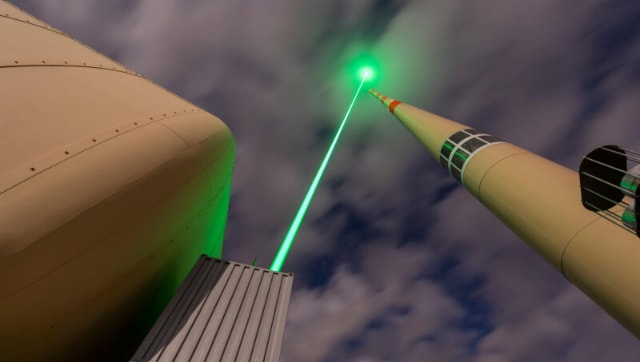Straight out of SciFi: Scientists use laser to guide lightning strikes to a safe place from critical targets
- Get link
- X
- Other Apps
A team of European researchers and scientists said on Monday that they have successfully guided lightning for the first time using a laser beam in the hopes that the method will help people avoid lethal lightning strikes and perhaps even cause them in the future.

Worldwide, lightning hits 40–120 times per second, killing more than 4,000 people each year and incurring billions of dollars in damage.
Yet the lightning rod, which was invented by American polymath Benjamin Franklin in 1749, continues to be the primary defence against these aerial bolts.
Since years, a group of scientists from six research institutes has been attempting to use the same concept but utilise a far more complex and accurate laser in lieu of the basic metal pole.
Now, they explain utilising a laser beam, shot from the peak of a Swiss mountain to guide a lightning bolt for more than 50 metres in a study that was just published in the journal Nature Photonics.
Aurelien Houard, a physicist at the ENSTA Paris institute’s applied optics department and the study’s principal author, stated, “We wanted to deliver the first evidence that the laser may have an effect on lightning, and it is easiest to guide it.
But for future applications “it would be even better if we could trigger lightning,” said Houard.
How to catch lightning?
Static energy that has accumulated in storm clouds or between clouds and the ground releases itself as lightning. Plasma, which is produced by the laser beam, heats the air with charged ions and electrons.
According to Houard, the air turns “partially conductive, and consequently a path favoured by the lightning.” In a similar experiment, conducted by scientists in New Mexico in 2004, their laser failed to capture the lightning.
According to Houard, that laser failed because it did not produce enough pulses per second to ignite lightning, which does so in milliseconds. It was also challenging to “predict where the lightning was going to land,” he continued.
For the latest experiment, the scientists left little to chance. They lugged a car-sized laser, which can fire up to a thousand pulses of light a second at up the 2,500-metre peak of Santis mountain in northeastern Switzerland.
The peak is home to a communications tower that is struck by lightning around 100 times year. The strong laser took two years to construct, and many weeks to transport it via cable car in sections. The enormous containers that would hold the telescope had to be dropped off by helicopter at the end.
The telescope focused the laser beam to a maximum intensity at a spot around 150 metres in the air just above the top of the 124-metre tow The beam has a diameter of 20 centimetres at the beginning but narrows to just a few centimetres at the top.
Riding the lightning
The researchers captured an image of their beam moving a lightning bolt 50 to 60 metres during a storm in the summer of 2021. Interferometric tests revealed that three further impacts were steered as well.
The majority of lightning develops from precursors inside the clouds, however, if the electric field is strong enough, some lightning may also rise from the ground. “Once the earth is connected to the cloud, the current and strength of a lightning bolt truly become obvious,” Houard added.
One of these predecessors is guided by the laser, making it “far quicker than the others ,and straighter,” the scientist claimed. Then, before it lights up, it will be the first to connect with the cloud. This means that, in theory, this technique could be used not just to drive lightning away, but to trigger it in the first place.
That could allow scientists to better protect strategic installations, such as airports or rocket launchpads, by igniting strikes at the time of their choosing. In practice, that would require a high conductivity in the laser’s plasma, which scientists do not think they have mastered yet.
from Firstpost Tech Latest News https://ift.tt/iIUFJxZ
- Get link
- X
- Other Apps
Comments
Post a Comment